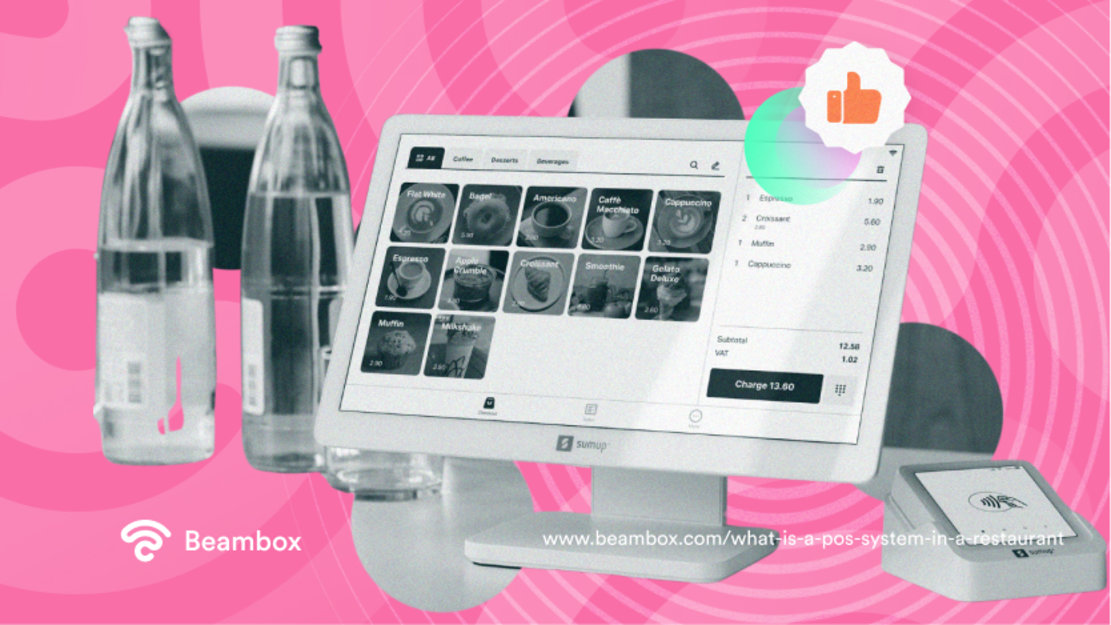Restaurants rapidly use new technology to simplify their operations and get more done. A POS is a perfect example of such innovation. But what is a POS system in a restaurant?
Contrary to popular belief, it’s about more than just taking orders and processing payments. Restaurants are taking advantage of integrations and other features to gather valuable insights. They use these systems to track their restaurant’s success, learn about their customers, and bring massive improvements.
This article is the perfect place to start if you want to do the same. So, let’s discuss the definition, costs, features, and benefits of POS in a restaurant!

What Is a POS System in a Restaurant?
A point-of-sale (POS) system in a restaurant is a tool for managing orders, processing payments, and tracking sales. While that’s the basic definition, people often want details when they ask, “What is a POS system in restaurant?”
A restaurant’s POS system lets servers enter customer orders and send them directly to the kitchen. It also tracks inventory, generates sales reports, and manages staff schedules. Whether you have a functioning diner or are opening a restaurant, you need a POS system.
But it’s not just about the software — you’ll need the right hardware, too, and that’s where costs can add up. Therefore, it’s essential to understand what you’re getting into before purchasing.
This leads us to another question: What hardware components do you need? Even if you go for the most basic system, the least you’ll need is:
- A POS terminal
- Kitchen Display System (KDS)
- A cash drawer
- Driver Display System (DDS)
- Customer Display System (CDS)
- Payment terminal
- Receipt printer
If we talk about the costs of a restaurant POS, you’ll have to invest somewhere between $60 to $250 monthly. In addition to this, there will be upfront hardware costs starting from $700. You might also have to pay a small fee per transaction.
However, this is just a rough estimate. The specific amount you’ll pay depends on your needs and providers.
6 Features and Benefits of a POS System That Make It Worth the Investment
Now that you know the basics of a POS system, let’s move on to its features and benefits. You might think all it does is process orders and take payments. While those are the main tasks, you can achieve a lot more.
That’s why it’s so important to learn about the true capabilities of a restaurant POS system. It will also help you choose the right system when you buy one. So, here are six reasons you should consider investing in this tool.

1. Order Management
There’s no concept of a restaurant POS system without order management features. After all, that’s one of the main reasons this tool entered the market.
With this feature, your servers can provide faster service by taking orders and sending them to the kitchen staff. You can also calculate waiting times and improve your customers’ experience.
Some POS systems even let you offer self-ordering to better fit customer preferences. Using this feature, customers don’t have to wait for your servers to arrive at their tables.
If you offer online delivery, POS systems can help you accurately track the order in real-time. As a result, you’ll be able to keep your customers informed, avoiding embarrassment and customer churn.
2. Inventory Management
Inventory management is one of the most important features of a POS system. You need to manage food costs and ensure enough inventory to fulfill the demand.
Tracking everything manually with pen and paper isn’t sustainable or efficient. Automating this process through the POS system will bring everything in one place. As a result, you’ll be able to reduce repetitive tasks and make better decisions regarding your inventory.

3. Staff Scheduling
Customers expect you to treat them like guests when they arrive at your restaurant. They want you to make them feel welcome, guide them through the menu, and provide proper attention.
However, you won’t always be at the forefront if you’re the restaurant owner. Therefore, these tasks will fall on your employees. Making sure they do this efficiently depends on how you schedule their shifts. Your employees must get proper rest and remain happy with their jobs.
Fortunately, a restaurant POS system helps with this through a built-in staff scheduling feature or an integration. As a result, you can use your resources to their full potential, reduce labor costs, and track staff performance.
4. Payment Integrations
Handling money is a challenging task, especially in a bustling restaurant. Even the slightest mistake can cost you severely. Instead, you need a system to calculate payments before processing and storing them.
Again, a POS system has features and tools that help you with this. However, it all depends on the provider you choose. Even if it doesn’t have built-in payment features, it should integrate your existing payment processing software.
As a result, you’ll never miss a penny. You’ll also be safe from theft and mishandling since the POS system will record everything.
A vast majority of the options allow you to offer contactless payments. Some even let you integrate Apple Pay and Google Pay to give your customers more choices and enhance their experience.

5. Marketing Features
An advanced POS system also offers marketing plans with built-in customer relationship management (CRM) software. It is a software that helps you manage customer data.
The POS system can use data from this software to personalize customer interactions. For example, you can offer an exclusive discount to a loyal customer. Or you can suggest a new dish related to one of their favorite menu items.
CRM systems also store customer communications, so you’ll have rich data at your disposal. As a result, you can make better upselling and cross-selling decisions, increasing your sales and profits.
6. Food Quality and Hygiene
Lastly, a POS system also helps you maintain food quality and hygiene. This might seem unimportant from the outlook, but keeping things unclean can put your restaurant in a lot of trouble. It might even lead to a complete shutdown.
So, choose a POS system that helps you with restaurant management. This means having integrated checklists, temperature logs, and the ability to print up-to-date paperwork. You can also track your cleaning schedule, assign duties, and train your staff about the latest food safety rules.
POS Experience Meaning: What Is It and How Does It Help You?
Customer experiences are everything in hospitality businesses. People must feel welcomed and properly cared for when they visit your restaurant. That brings us to a relatively underrated topic: POS experience meaning. At its core, it means how user-friendly and effective the system is for you and your customers.
For example, a slow POS system might annoy your customers. They might have a negative experience at your restaurant, which might discourage them from returning.
Additionally, you need high security since customers will share their personal information with you. Your POS system must also be able to integrate with your existing tools. This way, the customer will have an omnichannel experience without disruptions or inconsistencies.
It will also help you better track things and get a holistic view of your restaurant’s performance. Since that’s the first step to data-driven decisions, you can improve your operations to serve your customers better.
Moreover, people need quick responses and exceptional customer service from your employees. This won’t be possible if your employees don’t enjoy working at your place. You must give them the proper resources to fulfill their tasks in the best way. Your POS system is one such resource.
So, choose a system that supports your employees, making their work easier and improving their overall job satisfaction. As a result, they’ll be happier and more willing to treat your customers correctly.

Frequently Asked Questions About POS in Restaurant
After learning the details of a restaurant POS system, let’s answer some frequently asked questions before wrapping things up.
What is a POS system in a restaurant?
A restaurant point of sale system is a tool for taking orders, processing payments, and tracking sales.
It simplifies day-to-day tasks by combining order management, payment processing, and inventory tracking into one easy-to-use system. You can even use it to schedule your staff and make improvements.
How much does a restaurant POS system cost?
A restaurant POS system typically costs around $60 to $250 monthly. However, you will also need hardware components.
The minimum you’ll have to pay for these is $700, but it can increase depending on the provider you choose. Lastly, you also have to account for the transaction fee.
What are the four types of POS systems?
There are four types of POS systems: Tablet-based, legacy, cloud-based, and mobile. The one you choose will depend on your needs.
If you own a full-service restaurant, choosing more modern systems, like tablets or mobile, would be better. These would help your servers take orders more efficiently.
Streamline Your Restaurant Operations With a POS System
Understanding what is a POS system in a restaurant is the first step to using it effectively.
A POS helps you run your restaurant more efficiently with order management, payment processing, staff scheduling, and tracking features.
It also lets you take reviews and learn about your customers for data-driven decisions.
If you want to integrate your POS system with a marketing platform to run your marketing, try Beambox.
Beambox is an all-in-one WiFi marketing platform for managing your reputation online, growing your rating, and automating campaigns.
Start your trial today, and let us maximize the potential of POS and WiFi marketing!